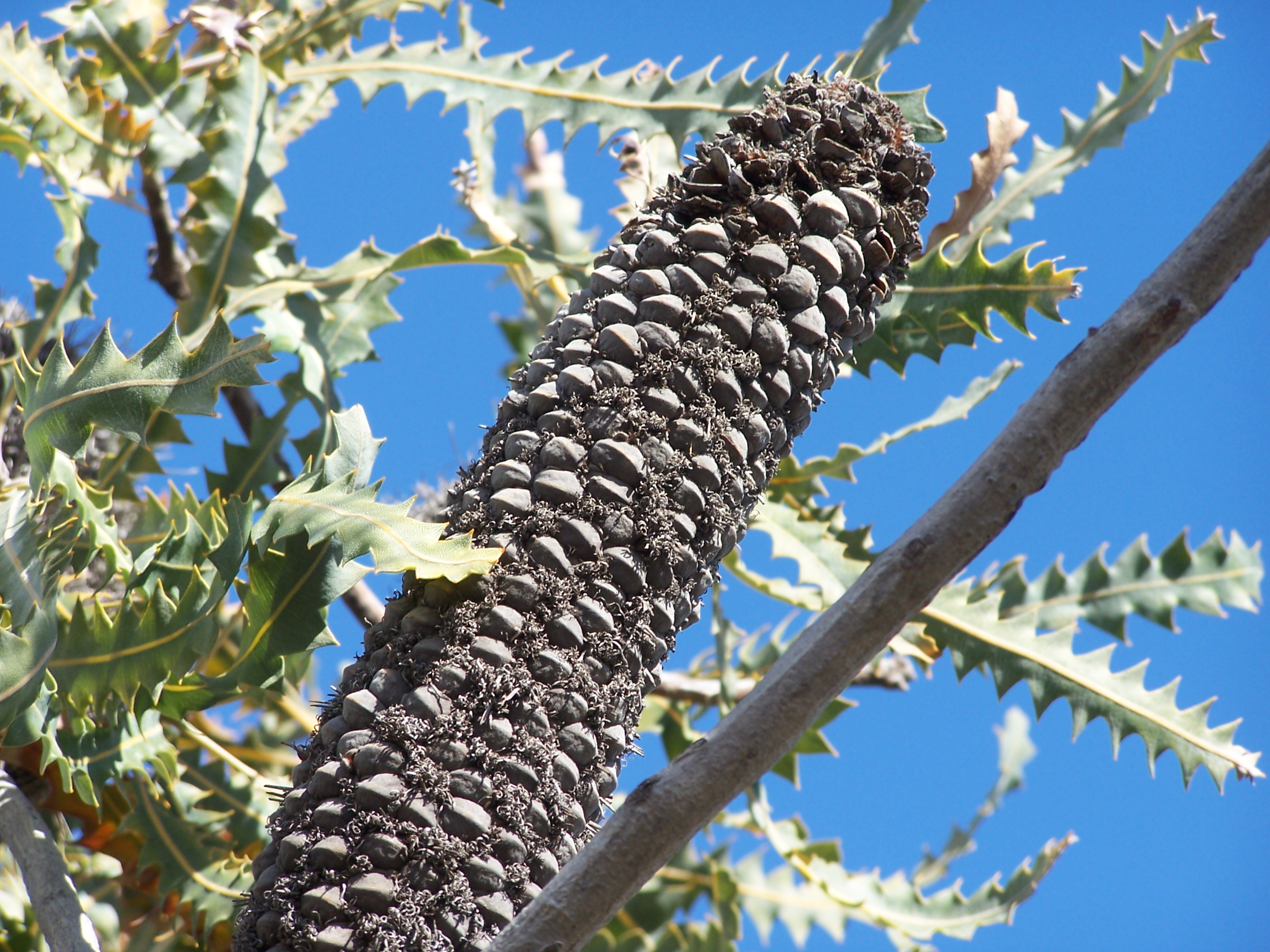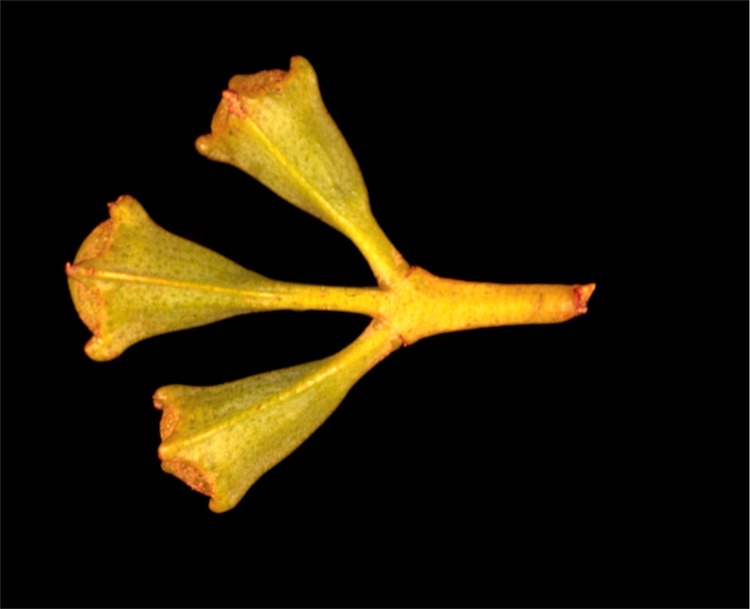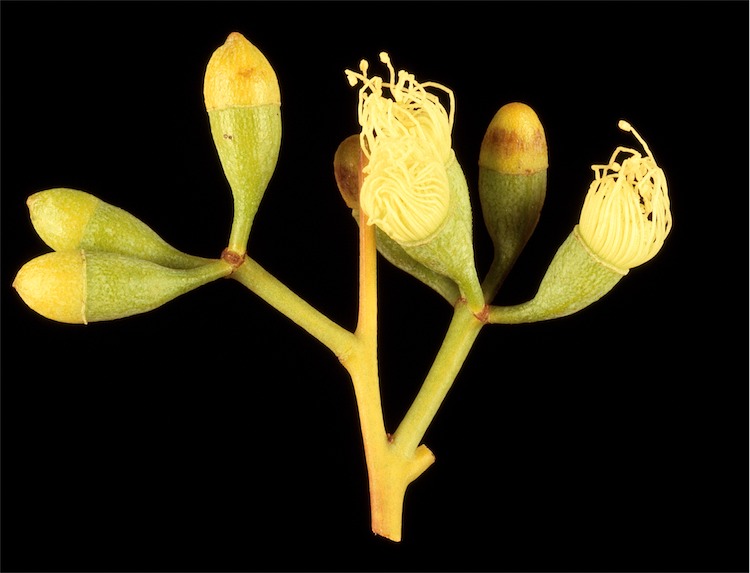|
Eucalyptus Beardiana
''Eucalyptus beardiana'', commonly known as Beard's mallee, is a mallee that is endemic to Western Australia. It has smooth pinkish bark, narrow lance-shaped to curved adult leaves, flower buds usually in groups of nine, pale yellow flowers and down-turned, hemispherical fruit. Description ''Eucalyptus beardiana'' is a spreading mallee that typically grows to a height of and forms a lignotuber. It has smooth grey, cream-cloloured or pinkish bark from the trunk to the thinnest branches. Young plants and coppice regrowth have dull, narrow lance-shaped leaves long and wide and have a petiole. Adult leaves are lance-shaped to curved, mostly long and wide, narrowing at the base to a petiole long. The flowers are usually borne in groups of nine, rarely eleven, in leaf axils on an unbranched peduncle long, the individual flowers on a pedicel long. Mature buds are oval, long and wide with a finely beaked operculum about long. Flowering mainly occurs from August to Septembe ... [...More Info...] [...Related Items...] OR: [Wikipedia] [Google] [Baidu] |
Murchison (Western Australia)
The Murchison is an interim Australian bioregion located within the Mid West of Western Australia. The bioregion is loosely related to the catchment area of the Murchison River and has an area of . Traditionally the region is known as ''The Murchison''. Geography The landscape is characterised by low hills and mesas, separated by colluvium flats and alluvial plains. The western portion of the bioregion is drained by the upper Murchison and Wooramel rivers, which drain westwards towards the coast.Anthony Desmond, Mark Cowan and Alanna Chant (2001). "Murchison 2 (MUR2 – Western Murchison subregion)", in ''A Biodiversity Audit of Western Australia’s 53 Biogeographical Subregions in 2002''. The Department of Conservation and Land Management, Government of Western Australia, November 2001/ref> Together with Gascoyne bioregion, it constitutes the Western Australian mulga shrublands ecoregion. Population is scattered; the largest population centres are Meekatharra, Mount ... [...More Info...] [...Related Items...] OR: [Wikipedia] [Google] [Baidu] |
Donald Blaxell
Donald Frederick Blaxell (born 1 February 1934, Sydney, New South Wales), is an Australian botanist, botanical collector and taxonomist. Blaxell worked at the University of New South Wales for 11 years and joined the New south Wales Herbarium in 1968. He was particularly interested in plants from family ''Orchidaceae'' and the genus ''Eucalyptus''. He worked extensively with Lawrence Alexander Sidney Johnson through the 1960s completing descriptions of many species. He was also an avid collector, particularly ''Eucalyptus'' species, usually with Johnson or L D. Pryor. Blaxell was appointed as the Australian Botanical Liaison Officer at Kew Gardens between 1974 and 1975. In 2001, he was awarded an OAM in the Australia Day honours. '' Eucalyptus blaxellii'' was named in his honour by L.A.S.Johnson Lawrence Alexander Sidney Johnson FAA, (26 June 1925 – 1 August 1997) known as Lawrie Johnson, was an Australian taxonomic botanist. He worked at the Royal Botanic Gardens, Sydne ... [...More Info...] [...Related Items...] OR: [Wikipedia] [Google] [Baidu] |
Persoonia
''Persoonia'', commonly known as geebungs or snottygobbles, is a genus of about one hundred species of flowering plants in the family Proteaceae. Plants in the genus ''Persoonia'' are shrubs or small trees usually with smooth bark, simple leaves and usually yellow flowers arranged along a raceme, each flower with a leaf or scale leaf at the base. The fruit is a drupe. Description Persoonias are usually shrubs, sometimes small trees and usually have smooth bark. The adult leaves are simple, usually arranged alternately but sometimes in opposite pairs, or in whorls of three or four. If a petiole is present, it is short. The flowers are arranged singly or in racemes, usually of a few flowers, either in leaf axils or on the ends of the branches. Sometimes the raceme continues to grow into a leafy shoot. The tepals are free from each other except near their base, have their tips rolled back and are usually yellow. There is a single stigma on top of the ovary and surrounded by fou ... [...More Info...] [...Related Items...] OR: [Wikipedia] [Google] [Baidu] |
Grevillea
''Grevillea'', commonly known as spider flowers, is a genus of about 360 species of evergreen flowering plants in the family Proteaceae. Plants in the genus ''Grevillea'' are shrubs, rarely trees, with the leaves arranged alternately along the branches, the flowers zygomorphic, arranged in racemes at the ends of branchlets, and the fruit a follicle that splits down one side only, releasing one or two seeds. Description Plants in the genus ''Grevillea'' are shrubs, rarely small trees with simple or compound leaves arranged alternately along the branchlets. The flowers are zygomorphic and typically arranged in pairs along a sometimes branched raceme at the ends of branchlets. The flowers are bisexual, usually with four tepals in a single whorl. There are four stamens and the gynoecium has a single carpel. The fruit is a thin-walled follicle that splits down only one side, releasing one or two seeds before the next growing season. Taxonomy The genus ''Grevillea'' was first forma ... [...More Info...] [...Related Items...] OR: [Wikipedia] [Google] [Baidu] |
Acacia
''Acacia'', commonly known as the wattles or acacias, is a large genus of shrubs and trees in the subfamily Mimosoideae of the pea family Fabaceae. Initially, it comprised a group of plant species native to Africa and Australasia. The genus name is New Latin, borrowed from the Greek (), a term used by Dioscorides for a preparation extracted from the leaves and fruit pods of ''Vachellia nilotica'', the original type of the genus. In his ''Pinax'' (1623), Gaspard Bauhin mentioned the Greek from Dioscorides as the origin of the Latin name. In the early 2000s it had become evident that the genus as it stood was not monophyletic and that several divergent lineages needed to be placed in separate genera. It turned out that one lineage comprising over 900 species mainly native to Australia, New Guinea, and Indonesia was not closely related to the much smaller group of African lineage that contained ''A. nilotica''—the type species. This meant that the Australasian lineage (by ... [...More Info...] [...Related Items...] OR: [Wikipedia] [Google] [Baidu] |
Melaleuca Uncinata
''Melaleuca uncinata'', commonly known as broombush, broom honeymyrtle or brushwood, is a plant in the paperbark family native to southern Australia. It is harvested from the wild, and grown in plantations, for broombush fencing. The Noongar names for the plant are kwytyat and yilbarra. Description Broombush is a multistemmed evergreen shrub usually less than in height, occasionally growing as a small tree to less than . It is often found in association with mallee eucalypts. It has spreading or ascending leaves, long and wide, linear in shape, almost circular in cross-section, and tapering to a distinctly curved hook. The leaves have large oil glands along their edges. The flowers are white, cream or yellow, and are attractive to birds. They are arranged in dense almost spherical heads, in diameter in the leaf axils. Each head contains 4 to 19 groups of flowers, each group with 3 flowers. The stamens are arranged in five bundles around the flower, each bundle with 3 to 5 ... [...More Info...] [...Related Items...] OR: [Wikipedia] [Google] [Baidu] |
Banksia Ashbyi
''Banksia ashbyi'', commonly known as Ashby's banksia, is a species of shrub or small tree that is Endemism, endemic to Western Australia. It has smooth, grey bark, deeply serrated, hairy leaves and spikes of bright orange flowers. Description ''Banksia ashbyi'' is a shrub or small tree that typically grows to a height of and sometimes forms a lignotuber. It has smooth, grey bark and young stems that are hairy at first but become wikt:glabrous, glabrous as they age. The leaves are broadly linear, long and wide and deeply serrated, the serrations triangular with sharply pointed tips. The flower spikes are bright orange, long and in diameter, each perianth long. Flowering occurs from February to May or July to December and the fruits are numerous smooth, elliptical to round Follicle (fruit), follicles long, high and wide with a covering of short, soft hairs. Taxonomy and naming ''Banksia ashbyi'' was first formally described in 1934 by Edmund Gilbert Baker in the ''Jour ... [...More Info...] [...Related Items...] OR: [Wikipedia] [Google] [Baidu] |
Banksia Sceptrum
''Banksia sceptrum'', commonly known as the sceptre banksia, is a plant that grows in Western Australia near the central west coast from Geraldton north through Kalbarri to Hamelin Pool. It extends inland almost to Mullewa. First collected and grown by early settler James Drummond in Western Australia, it was described by Swiss botanist Carl Meissner in 1855. In nature, ''B. sceptrum'' grows in deep yellow or pale red sand in tall shrubland, commonly on dunes, being found as a shrub to high, though often smaller in exposed areas. It is killed by fire and regenerates by seed, the woody follicles opening with fire. ''B. sceptrum'' is one of the most striking yellow-flowered banksias of all. Its tall bright yellow spikes, known as inflorescences, are terminal and well displayed. Flowering is in summer, mainly December and January, though flowers are occasionally seen at other times. The common name 'sceptrum' is due to the prominent spiky bracts which resemble a ceremonial ma ... [...More Info...] [...Related Items...] OR: [Wikipedia] [Google] [Baidu] |
Eucalyptus Gittinsii
''Eucalyptus gittinsii'', commonly known as northern sandplain mallee, is a species of mallee that is endemic to Western Australia. It has smooth greyish bark, sometimes with rough flaky bark near the base, lance-shaped to curved adult leaves, flower buds in groups of three, whitish flowers and cylindrical to barrel-shaped fruit. Description ''Eucalyptus gittinsii'' is a mallee that typically grows to a height of and forms a lignotuber. It has smooth brownish to white bark, sometimes with rough, flaky bark that peels off near the base of the trunk. Young plants and coppice regrowth have leaves arranged in opposite pairs, broadly lance-shaped, long and wide. Adult leaves are arranged alternately, lance-shaped to curved, long and wide on a petiole long long. The flower buds are arranged in leaf axils in groups of three on a peduncle long, the individual buds on pedicels long. Mature buds are club-shaped, long and wide with a rounded to flattened operculum. Flowering oc ... [...More Info...] [...Related Items...] OR: [Wikipedia] [Google] [Baidu] |
Eucalyptus Eudesmioides
''Eucalyptus eudesmioides'', commonly known as mallalie, desert gum or mallabie is a species of mallee that is endemic to Western Australia. It is a rounded, bushy mallee with smooth bark, egg-shaped to heart-shaped leaves arranged in opposite pairs, club-shaped flower buds arranged in groups of three, whitish flowers and cylindrical to barrel-shaped fruit. Description ''Eucalyptus eudesmioides'' is a mallee, sometimes a tree, that typically grows to high, occasionally up to but usually less than , and forms a lignotuber. It usually has smooth white to grey or brownish bark, sometimes with a rough, fibrous grey to brown bark near the base of the trunk. Young plants and coppice regrowth have sessile, egg-shaped to heart-shaped leaves arranged in opposite pairs and long, wide. Adult leaves are also arranged in opposite pairs and are lance-shaped to curved, long and wide on a petiole long. The flower buds are arranged in leaf axils in groups of three on a peduncle long, th ... [...More Info...] [...Related Items...] OR: [Wikipedia] [Google] [Baidu] |
Eucalyptus Jucunda
''Eucalyptus jucunda'', commonly known as Yuna mallee, is a species of mallee or small tree that is endemic to Western Australia. It has smooth bark, lance-shaped to curved adult leaves, flowering buds in groups of seven or nine, white or cream-coloured flowers and barrel-shaped or shortened spherical fruit with an unusually narrow opening. Description ''Eucalyptus jucunda'' is a mallee that typically grows to a height of , sometimes a tree to , and forms a lignotuber. It has smooth greyish to creamy brown bark, sometimes with crumbly, fibrous, flaky or ribbony bark at the base. Young plants and coppice regrowth have glaucous, sessile leaves arranged in opposite pairs. The juvenile leaves are egg-shaped to heart-shaped, long and wide. Adult leaves are lance-shaped, the same dull shade of green on both sides, long and wide on a petiole wide. The flower buds are arranged in leaf axils in groups of seven or nine, on a sometimes branched peduncle long, the individual buds on ... [...More Info...] [...Related Items...] OR: [Wikipedia] [Google] [Baidu] |
John Stanley Beard
John Stanley Beard (15 February 1916 – 17 February 2011) was a British-born forester and ecologist who resided in Australia. Beard studied at the University of Oxford where he completed his doctoral thesis on tropical forestry. While working with the Forestry Division in Trinidad and Tobago during the 1940s, Beard developed a system of forest classification for Tropical America and described the forests of Trinidad, Tobago, and the Lesser Antilles; these descriptions remain standard references on the topics. After leaving Trinidad, Beard moved to South Africa and then to Australia, where he produced an extensive series of vegetation maps covering much of the country. His extensive surveys of Western Australia set standards for understanding regional floristic zones and biogeographical areas for the whole state. He was the main author of the 1964–1981 explanatory notes to the mapping project of the '' Vegetation Survey of Western Australia'', which involved travelling some ... [...More Info...] [...Related Items...] OR: [Wikipedia] [Google] [Baidu] |

.jpg)





